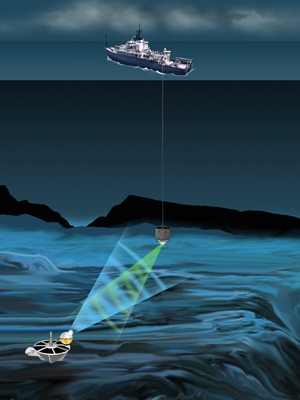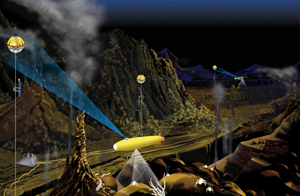Introduction

Data Retrieval from Fixed Sensors
Instrumentation such as Ocean Bottom Seismometers (OBS) or CORK wellheads [Davis et. al., 1992, 2001] that are installed semi-permanently and collect large quantities of data would benefit greatly from optical modem data recovery. A ship-lowered optical modem could wirelessly connect to an installed instrument and download large data files in time spans from a few minutes to a few hours (Figure 1). An integrated acoustic link with navigation capability would allow the two ends of the optical link to be maneuvered into position so that a robust optical connection could be maintained. Given that the expected range of an optical data link is approximately 100 meters, it is quite possible for a ship without dynamic positioning to be used for such tasks. At 10 Mbps, large data files could be transferred very efficiently. This type of periodic data recovery would verify that the seabed systems were operating correctly and provide a complete data set for scientific analysis prior to instrument recovery, which might be years in the future. At present such data retrieval often requires the use of specialized robots or deep-diving submersibles.

Cabled Observatories
Cabled sensor networks utilize seafloor junction boxes containing power and communication electronics and wet mateable connectors to connect instruments to the cable backbone. Instruments located at some distance from the junction box must be cabled back to the junction box. Replacing these extension cables with battery powered sensors equipped with optical modems could simplify installation and maintenance and reduce long-term costs of the network without significantly impacting either data throughput or real-time data delivery. Read more
Mobile platforms operating as part of a cabled network are an economically viable way to support a diverse class of chemical and biological sensors (e.g., mass and Raman spectrometers or genomic and other biological sensors). An AUV that is operated within a real-time optical communication network can be moved as the scientific needs change. Direct human control of the vehicle is facilitated by a real-time video link and thus will combine some attributes of AUVs (e.g., no tether, internal battery power) and of ROVs (e.g., real-time data flow and control by skilled operators). In essence, scientists or educators located anywhere on the Internet would be able to directly interact with the oceanic environment. The enabling technology to implement this use scenario is wireless, or free-water, optical communication networks connected to an ocean observatory infrastructure. Figure 2 shows this use case scenario in a deep ocean hydrothermal vent field.
While this use scenario is focused on deep ocean vent fields, it is illustrative rather than unique. Optical communication technology has applications in all fields of oceanography in regimes from estuaries to the coastal zone to the deep ocean.
ROV Operation
Free-water optical communications coupled with recent advances in robotic systems make it possible to consider supplementing many of the functions performed by present deep submergence tools such as the Jason ROV system with a new generation of semi-autonomous vehicles that are far less expensive to build and operate. While it will be some time before we can expect such a new class of vehicle to completely supersede tethered vehicles, it is clear that a battery operated vehicle utilizing a new tethering technique enabled by an optical communication system as proposed here, will improve access by lowering costs. An intervention Un-Tethered ROV (UTROV) would be able to perform a variety of useful tasks such as:
- Rapid event response
- Deployment from a wider variety of ships than present tethered ROVs, including non-dynamically positioned ships
- Ocean Observatory maintenance including both moored and cabled systems
Read more
An optical link used in place of the fiber-optic tether between a battery-powered ROV and its garage (from Jason to Medea, for example) would allow more flexible operation of the ROV and the potential to operate the ROV from a less capable and less expensive ship with a smaller operational team. The UTROV concept hinges on a low latency link and the optical modem is suitable for this application. A high speed optical link provides both real-time video for operator control and real-time engineering data updates as well as a communication link to deployed instruments with optical modems [Bowen et. al., 2008a].
In shallow water an ROV with a free-water optical link could be used without a tether of any kind, assuming that it had adequate power from batteries. In fact, a recent dock trial using the Nereus HROV vehicle [Bowen et. al., 2008b] and a prototype version of the optical modem demonstrated the viability of an optically transmitted video picture in support of manipulative vehicle tasks (Figures 8 and 9). In addition to allowing more cost effective access to the deep ocean, tether-free operation would be a significant simplification for small, inexpensive ROVs operating in coastal waters since tether drag and tether management are major design and power issues for this class of ROV.
